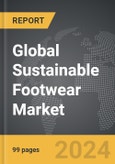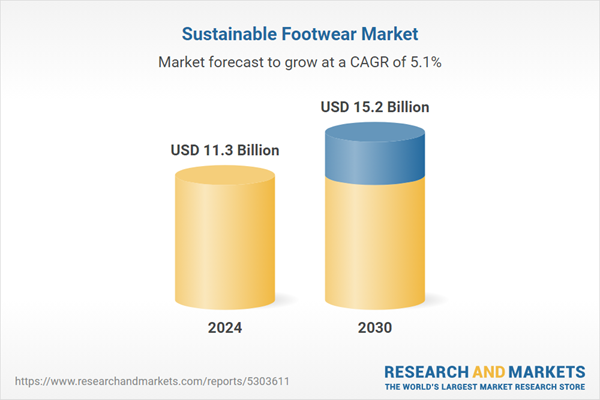The global market for Sustainable Footwear was valued at US$11.3 Billion in 2024 and is projected to reach US$15.2 Billion by 2030, growing at a CAGR of 5.1% from 2024 to 2030. This comprehensive report provides an in-depth analysis of market trends, drivers, and forecasts, helping you make informed business decisions. The report includes the most recent global tariff developments and what they mean for your business.
Segments: Type (Non-Athletic, Athletic); End-Use (Women, Men, Children).
Geographic Regions/Countries: World; United States; Canada; Japan; China; Europe (France; Germany; Italy; United Kingdom; and Rest of Europe); Asia-Pacific; Rest of World.
The analysts continuously track trade developments worldwide, drawing insights from leading global economists and over 200 industry and policy institutions, including think tanks, trade organizations, and national economic advisory bodies. This intelligence is integrated into forecasting models to provide timely, data-driven analysis of emerging risks and opportunities.
Global Sustainable Footwear Market - Key Trends and Drivers Summarized
How Is Sustainable Footwear Redefining the Fashion Industry?
Sustainable footwear refers to shoes made using environmentally friendly materials, ethical production methods, and waste-reducing designs. These shoes often use organic materials like hemp, recycled rubber, and vegan leather, promoting eco-friendly practices throughout the supply chain. This segment of the footwear industry aims to reduce the environmental impact of traditional shoe production, which is often associated with high carbon emissions, water consumption, and waste. As consumers become increasingly conscious of the environmental impact of their purchases, sustainable footwear has gained momentum, creating a shift toward responsible fashion in both casual and athletic shoe segments.What Are the Key Segments in the Sustainable Footwear Market?
Key product types include casual footwear, athletic footwear, and formal footwear, with casual footwear holding a significant market share due to its everyday use and versatility in design. Materials used in sustainable footwear include recycled plastic, organic cotton, natural rubber, and vegan leather, with recycled plastic leading the segment driven by its wide availability and growing focus on reducing ocean and landfill waste. Distribution channels cover online platforms, specialty stores, and retail chains, with online platforms showing strong growth as consumers prefer the convenience, variety, and detailed information available for sustainable products online.How Is Sustainable Footwear Integrated Across Consumer Markets?
In casual footwear, sustainable materials like recycled canvas and natural rubber soles offer eco-friendly alternatives without compromising comfort or durability. In the athletic segment, brands incorporate recycled fibers, biodegradable materials, and innovative designs to provide performance footwear that aligns with eco-conscious values. Sustainable formal footwear uses plant-based leathers and organic dyes, offering fashion-forward options for the professional and luxury market. Additionally, sustainable footwear is not limited to material sourcing but extends to circular models such as recycling initiatives, take-back programs, and biodegradable packaging, which resonate with environmentally aware consumers and support a holistic approach to sustainability.What Factors Are Driving the Growth in the Sustainable Footwear Market?
The growth in the Sustainable Footwear market is driven by several factors, including rising consumer awareness about environmental issues, the adoption of ethical practices by footwear brands, and advancements in sustainable materials. Innovations like bio-based leather, recycled fabrics, and closed-loop recycling processes have supported broader applications of sustainable footwear across various segments. The focus on reducing carbon footprints, minimizing waste, and promoting ethical labor practices has further fueled demand, as sustainable footwear aligns with broader sustainability goals and consumer preferences. Additionally, regulatory measures encouraging eco-friendly production, growing e-commerce platforms, and brand marketing campaigns emphasizing transparency have contributed to market growth, encouraging the adoption of sustainable footwear globally.Report Scope
The report analyzes the Sustainable Footwear market, presented in terms of units. The analysis covers the key segments and geographic regions outlined below.Segments: Type (Non-Athletic, Athletic); End-Use (Women, Men, Children).
Geographic Regions/Countries: World; United States; Canada; Japan; China; Europe (France; Germany; Italy; United Kingdom; and Rest of Europe); Asia-Pacific; Rest of World.
Key Insights:
- Market Growth: Understand the significant growth trajectory of the Non-Athletic segment, which is expected to reach US$11.0 Billion by 2030 with a CAGR of a 5.5%. The Athletic segment is also set to grow at 4.1% CAGR over the analysis period.
- Regional Analysis: Gain insights into the U.S. market, valued at $3.1 Billion in 2024, and China, forecasted to grow at an impressive 4.6% CAGR to reach $2.4 Billion by 2030. Discover growth trends in other key regions, including Japan, Canada, Germany, and the Asia-Pacific.
Why You Should Buy This Report:
- Detailed Market Analysis: Access a thorough analysis of the Global Sustainable Footwear Market, covering all major geographic regions and market segments.
- Competitive Insights: Get an overview of the competitive landscape, including the market presence of major players across different geographies.
- Future Trends and Drivers: Understand the key trends and drivers shaping the future of the Global Sustainable Footwear Market.
- Actionable Insights: Benefit from actionable insights that can help you identify new revenue opportunities and make strategic business decisions.
Key Questions Answered:
- How is the Global Sustainable Footwear Market expected to evolve by 2030?
- What are the main drivers and restraints affecting the market?
- Which market segments will grow the most over the forecast period?
- How will market shares for different regions and segments change by 2030?
- Who are the leading players in the market, and what are their prospects?
Report Features:
- Comprehensive Market Data: Independent analysis of annual sales and market forecasts in US$ Million from 2024 to 2030.
- In-Depth Regional Analysis: Detailed insights into key markets, including the U.S., China, Japan, Canada, Europe, Asia-Pacific, Latin America, Middle East, and Africa.
- Company Profiles: Coverage of players such as Adidas Group, Amour Vert, Matisse Footwear, Native Shoes, Nisolo and more.
- Complimentary Updates: Receive free report updates for one year to keep you informed of the latest market developments.
Some of the 53 companies featured in this Sustainable Footwear market report include:
- Adidas Group
- Amour Vert
- Matisse Footwear
- Native Shoes
- Nisolo
- Reformation
- Rothy's
- Threads 4 Thought
- Tropicfeel
- Veja
Tariff Impact Analysis: Key Insights for 2025
Global tariff negotiations across 180+ countries are reshaping supply chains, costs, and competitiveness. This report reflects the latest developments as of April 2025 and incorporates forward-looking insights into the market outlook.The analysts continuously track trade developments worldwide, drawing insights from leading global economists and over 200 industry and policy institutions, including think tanks, trade organizations, and national economic advisory bodies. This intelligence is integrated into forecasting models to provide timely, data-driven analysis of emerging risks and opportunities.
What’s Included in This Edition:
- Tariff-adjusted market forecasts by region and segment
- Analysis of cost and supply chain implications by sourcing and trade exposure
- Strategic insights into geographic shifts
Buyers receive a free July 2025 update with:
- Finalized tariff impacts and new trade agreement effects
- Updated projections reflecting global sourcing and cost shifts
- Expanded country-specific coverage across the industry
Table of Contents
I. METHODOLOGYII. EXECUTIVE SUMMARY2. FOCUS ON SELECT PLAYERSIII. MARKET ANALYSISIV. COMPETITION
1. MARKET OVERVIEW
3. MARKET TRENDS & DRIVERS
4. GLOBAL MARKET PERSPECTIVE
UNITED STATES
CANADA
JAPAN
CHINA
EUROPE
FRANCE
GERMANY
ITALY
UNITED KINGDOM
REST OF EUROPE
ASIA-PACIFIC
REST OF WORLD
Companies Mentioned (Partial List)
A selection of companies mentioned in this report includes, but is not limited to:
- Adidas Group
- Amour Vert
- Matisse Footwear
- Native Shoes
- Nisolo
- Reformation
- Rothy's
- Threads 4 Thought
- Tropicfeel
- Veja
Table Information
| Report Attribute | Details |
|---|---|
| No. of Pages | 99 |
| Published | April 2025 |
| Forecast Period | 2024 - 2030 |
| Estimated Market Value ( USD | $ 11.3 Billion |
| Forecasted Market Value ( USD | $ 15.2 Billion |
| Compound Annual Growth Rate | 5.1% |
| Regions Covered | Global |









